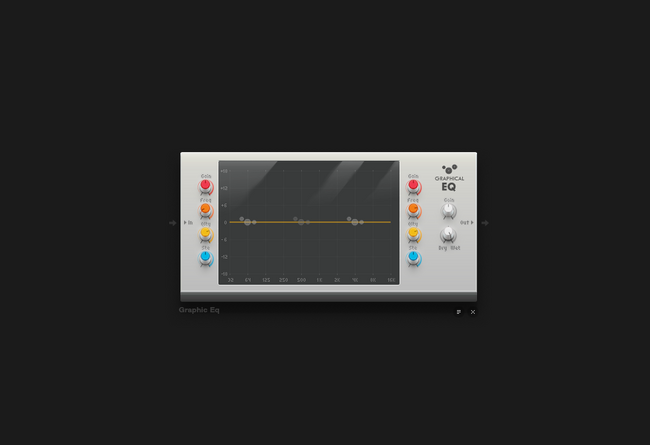The graphical equalizer is a powerful device which can be used to boost or suppress specific frequency ranges. The graphical equalizer consists of 2 filters which can be controlled individually either by adjusting the 2 sets of filter parameters on both sides of the device or by adjusting each filters planet/satellites that are found on each side the the graphical display. Each filter allows control over the gain, center frequency, bandwidth and stereo spread. What makes a graphical EQ special is that it is possible to draw exactly where you want each filter to go on the devices display, with the frequency being displayed horizontally and the gain being displayed vertically.


The image shows the 2 filter controls and their planet/satellites. Everything that can be done with the filter's parameters can be done by adjusting each filter's planet and satellites, as well as this both filter's can be controlled at the same time by using the global planet/satellites found in the center of the graphical display.
The above image also shows the the devices master gain and dry/wet controls. The gain controls the overall gain of the device and the dry/wet controls how much the signal will be affected by the device. The Graphical Equalizer dos not include a bypass button but if the dry/wet control is turned to 0% the device will be bypassed and the signal will go from the input to the output unchanged.
Controlling the filters[]
As already mentioned the exact same settings can be made by using either the separate parameter controls for each filter or by using each filter's corresponding planets/satellites. All of the planets and satellites can be used to adjust the cut-off frequency of the filter(s) as well as this each Planet and satellite are colour-coded (on rollover) and correspond to one of the filter parameters. There are also a number of shortcuts which can be used to change the behaviour of the planets.

The example only shows filter(A) working since both filters controls work in exactly the same way.
- gain - The gain works on the vertical axis, the higher the gain the more that frequency range will be boosted. The gain has a range between -18dB and +18dB.
- frequency - The frequency parameter works on the horizontal axis with low frequencies being on the left of the display and the high frequencies on the right.
- quality - The quality refers to the bandwidth in which the filter will operate.
- stereo - The stereo parameter allows for the gain for the left and right channels to be offset.
- filter(A) planet - Dragging the filter's planet around the display allows for the gain and the frequency range to be adjusted. Holding <ctrl> (cmd for mac) while dragging the planet will make it so that the planet will be adjusting the quality and the cut-off frequency instead of the gain and the frequency. Holding <shift> while dragging the planet will make it so that the planet is controlling the frequency and the stereo spread.
- filter(A) quality satellite - Dragging the quality satellite around the display allows for the cut-off frequency and the quality to be adjusted.
- filter(A) stereo satellite - Dragging the stereo satellite allows for the cut-off frequency and the stereo spread to be adjusted.
